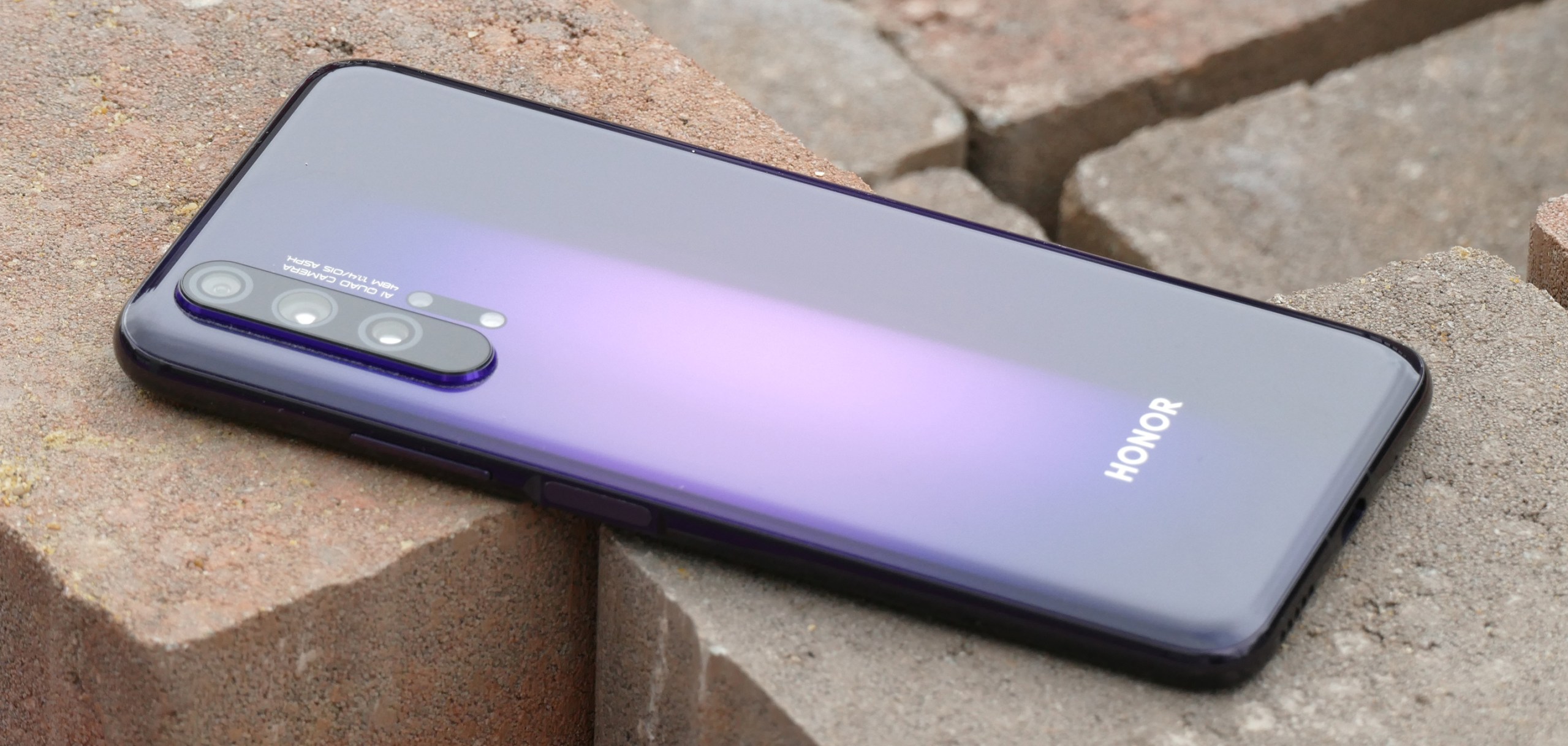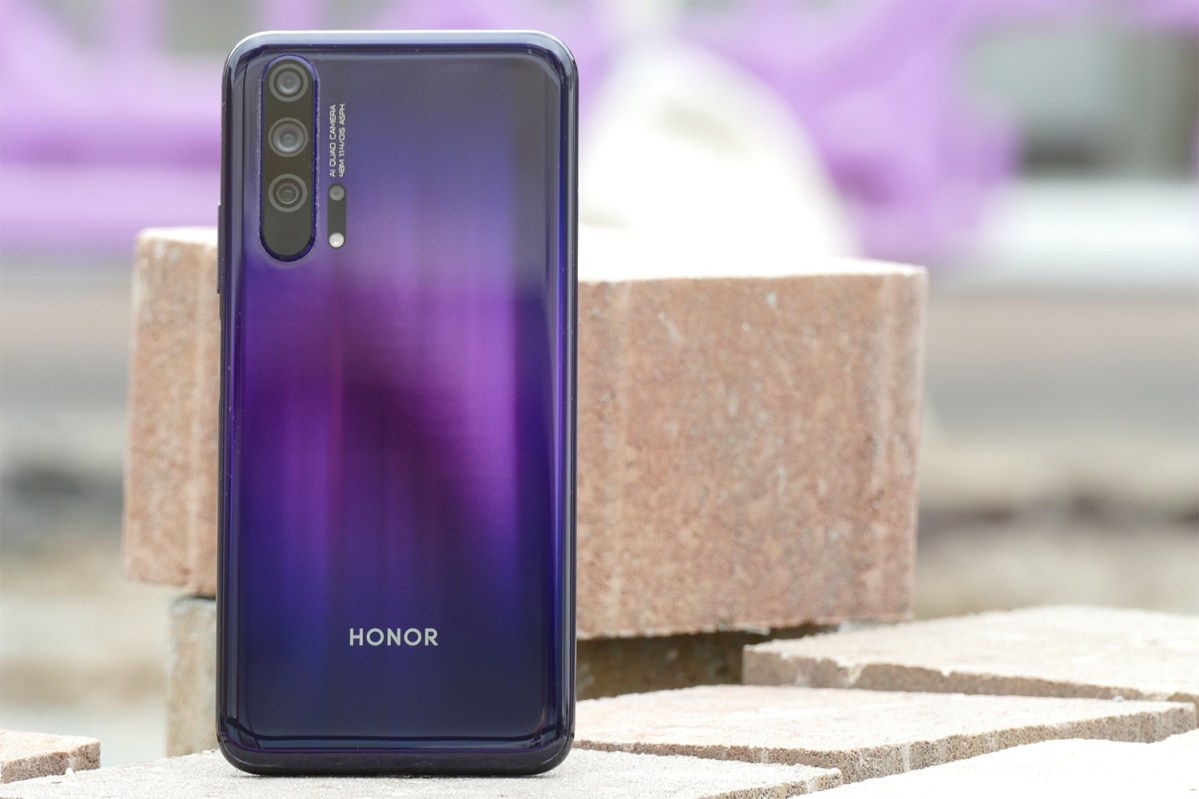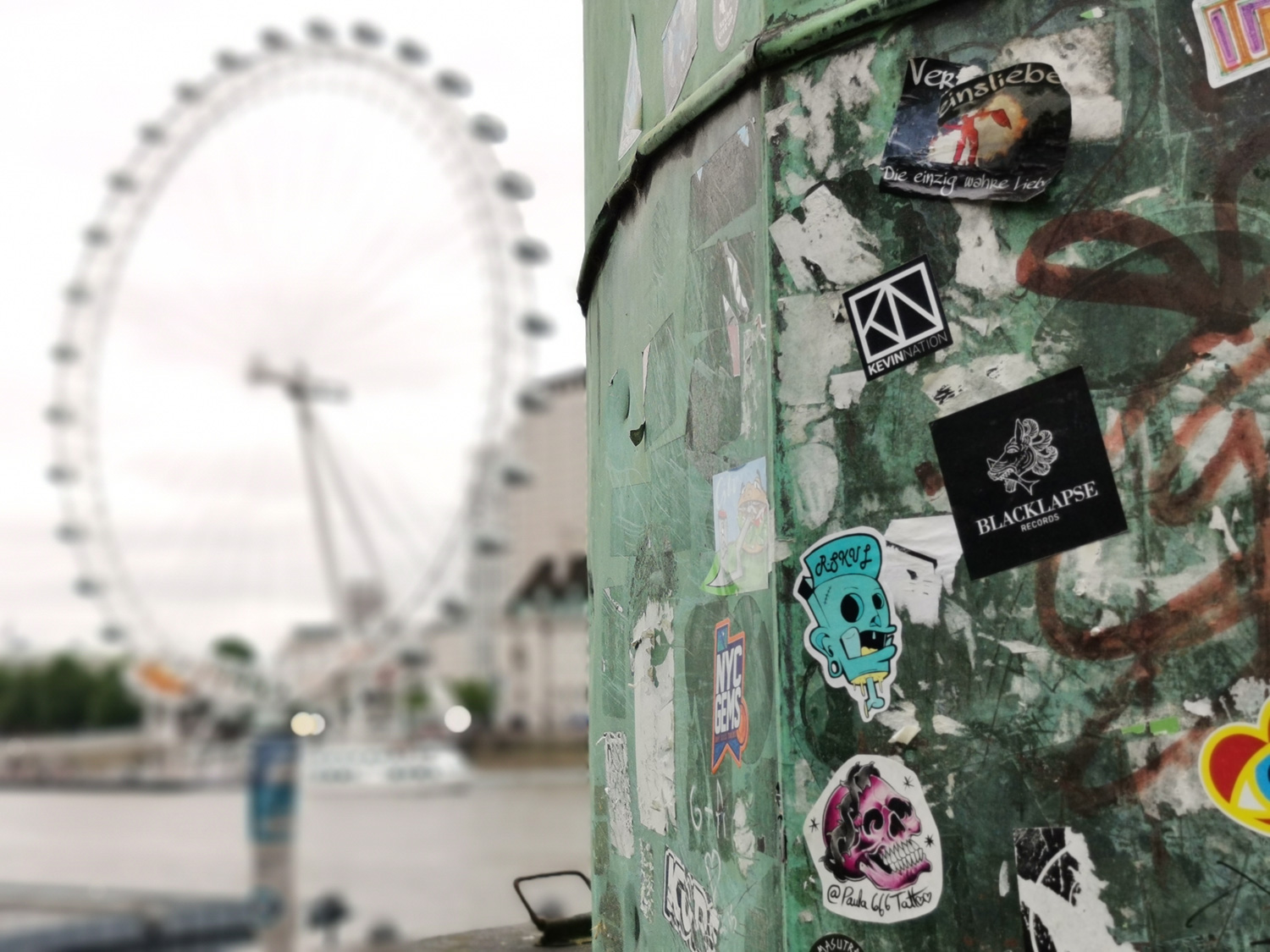“The Honor 20 Pro is an accomplished, capable, and mature smartphone that happily slips in your pocket.”
- Feature packed camera
- Compact size
- Long-lasting battery
- Hole-punch screen is great for games
- Competitive price
- No U.S. release date
- Question marks over long-term Android software support
- Large, protruding camera risks possible damage
- Camera software needs refining
Where does Honor go after the Honor View 20, which I described as the best device it has ever made? The answer is the Honor 20 Pro, which takes what made the View 20 great, and then makes it even better by adding more camera lenses, and shrinking the size. The result is a compact smartphone with desirable photographic skills, that pushes past the controversy surrounding the brand at the time of its launch.
It’s not perfect, though. Chief among the issues is a lack of identity. The View 20 is recognizable and individual, mainly due to the outrageous styling on the back. Sadly, the Honor N-series (that’s N for numbered and it refers to the Honor 20 and its predecessors) is still rather lost. The back of the phone recalls the Huawei P30 Pro, with its side-mounted camera array, and although the purple color seen here is attractive, it doesn’t shout out that this is an Honor phone.
Honor has compounded this identity crisis by adding further confusion with the Pro suffix. It’s the first time it has slapped a Pro name on this range, and it’s simply not needed. Yes, Huawei does it, but that doesn’t mean Honor has to as well. This has also meant Honor has diluted the range with several lesser models, including a regular Honor 20. Why isn’t the Pro just the Honor 20? Why do we need a 20, and even a Lite version?
Honor’s answer is that, “one phone is not enough to meet the demands of everyone.” In reality, the Honor 20 Pro is more than enough smartphone for most.
Compact design
This is a good-looking phone, it just doesn’t stand out. The glass rear panel is a complex item to make, with three layers — glass, color, and depth — composited together to create a holographic design, which is more durable than simply using three separate layers. Only 20 out of every 100 panels are selected for use on an Honor 20 Pro, highlighting not only Honor’s standards, but also how tough the finish is to get right. It’s a success. Calling it “deep” isn’t just marketing. The color weaves, shifts, and flows seemingly inches under the surface, like a restless spirit is trapped inside.

There’s no fingerprint sensor on the back, and it’s not under the screen either. It’s set inside an oversized power button on the side of the phone, much like the Samsung Galaxy S10e. It’s recessed into the body and set directly below a standard volume rocker. At first I found myself pressing the volume down button rather than locating the fingerprint sensor, but it became more natural after a short period of adjustment. That aside, it’s refreshing not to have to battle with a substandard security method, and it’s fast to unlock the phone in only 0.5 seconds.
Flip the phone over and you see a 6.26-inch LCD screen with a hole-punch camera — no notch here, and it’s a great design — and a 91.6% screen-to-body ratio. It’s colorful and pretty, but I always miss the lack of always-on display when using an LCD phone over an AMOLED phone. Additionally, it lacks that visual punch of deeper blacks and better contrast that makes an AMOLED panel so special. The hole-punch is a winner though.
If you’re lusting after a compact flagship-spec phone, the Honor 20 Pro will impress.
The bezels are noticeable, but mainly because they blend into the curvy, rounded sides of the body. Despite the size of the screen, the Honor 20 Pro is very compact. Coming from the OnePlus 7 Pro, the Honor 20 Pro feels very small indeed. I can close my hand around the entire phone so my finger and thumb easily touch, though you’ll notice the phone’s relative thickness. Thankfully, the body is grippy and won’t slip out of your hand easily.
I’ve enjoyed using a phone that feels small, but actually isn’t small at all. In particular, and this may sound slightly silly, the way it slips into my pocket without being annoying. If you’re lusting after a compact flagship-spec phone, the Honor 20 Pro will impress.
Versatile camera
Sounds like a nice design, right? For the most part it is, until your fingers reach the gigantic camera bump. If the Honor 20 Pro’s holographic finish on the back looks deep enough to sail the Titanic through, then the camera bump is the iceberg huge enough to sink it.
Long and standing proud of the body by several millimeters, it’s marred further by sharp edges. It’s not just aesthetics that’s the problem. It comes into direct contact with every surface you put the phone on, risking scratches on the lens; plus the phone wobbles about when face-up, and there’s no case included in the box to offer any protection. At least the camera hides some serious technology, justifying the bump’s size.
A 48-megapixel camera lens, the same IMX586 sensor seen on the View 20, takes center stage, and it’s joined by a 16-megapixel wide-angle, a 2-megapixel depth sensor, and a 2-megapixel macro lens. The 1/2-inch main sensor has an astonishing f/1.4 aperture, optical image stabilization (OIS), and artificial intelligence stabilization (AIS), plus the array provides features including a 3x optical zoom, a macro mode, Super Night Mode, 4K video, and A.I. scene recognition too.
The Honor 20 Pro’s camera is wonderfully versatile. The combination of a wide-angle lens, a high-megapixel low-light-sensitive main lens, and a 3x zoom is excellent, and you always feel like the camera will be capable of capturing the photo you want, regardless of the environment or situation. Sometimes, the camera astounds with stunning colors, great night time shots filled with detail and atmosphere, and easily manipulated bokeh shots. Other times, it overexposes slightly, and washes out bright environments.
Night performance is excellent, especially as it operates in wide-angle mode too, giving you more creative opportunity. I found it was easier to maintain atmosphere — rather than making night shots too bright — on the Honor 20 Pro than the Huawei P30 Pro, which is perhaps too effective in low light. The Honor 20 Pro’s Macro Mode isn’t very good, producing low quality pictures when it does eventually focus on its subject, and even then it’s hit-or-miss whether it captures what you want. Focusing was often a problem outside of the macro mode too, with the camera focusing on the background, rather than a foreground object.
The selfie camera is hidden inside the hole-punch screen on the front, set right in the top left corner, and it has stayed concealed by Honor’s fun parrot wallpaper since I started using the phone. It has 32-megapixels, but it doesn’t handle bright situations very well and although there is plenty detail, skin tones are much lighter than reality. The Portrait mode did not always operate on our early review version, which is likely a software issue.
Overall, despite the few software problems and some spotty features, the Honor 20 Pro has been a great camera sidekick, taking the photos I wanted to capture quickly and without fuss, and often really impressing with the results.
Software
On screen is Magic UI 2.0 layered over Android 9 Pie. Despite the different name, it’s essentially exactly the same as Huawei’s EMUI user interface. I have been using a pre-release version of the phone, and couldn’t install certain benchmarking apps. All other apps installed and operated normally. Over my time with the Honor 20 Pro, it has proved to be reliable and I have not experienced any major software problems.
Two new pre-installed apps join an ever-growing list of pre-installed apps on the Honor 20 Pro.
I find EMUI and Magic UI to be acceptable for everyday use, provided you do some tweaking right at the start. On the Honor 20 Pro, the home screen is set to a 4 x 4 icon layout, making it look like the big print version of a book. Set it to a 5 x 4 layout, and it is considerably better. It’s fast and smooth, with attractive animations. Not all the apps have a consistent icon shape though, and complaints over the design of pre-installed apps are justified, as they do look quite cartoonish.
Notifications are still problematic, and this is an EMUI problem rather than an Honor 20 Pro issue. The lack of an OLED panel exasperates this, as the screen isn’t always on. Notifications don’t always light up the screen, and when they do it’s simply an icon. Many notifications can be interacted with through the notification shade, but it’s not as wide-ranging as on phones like the Google Pixel 3. I find myself using the shade as a shortcut to the relevant app to deal with many notifications.
Two new pre-installed apps join an ever-growing list of pre-installed apps on the Honor 20 Pro. Joining a shortcut to install Epic Games’ Fortnite is Amazon Alexa, offering up an alternative to Google Assistant. The Alexa app is good, and there is the chance to set Alexa as the default assistant on the phone, but there’s no real reason to use it instead of the deeply baked-in Google Assistant. There are many other app alternatives onboard, actually — a browser, both Huawei’s and Honor’s store apps, an email app, and a weather app, plus a collection of tools and services including file manager, a voice recorder, and a tips app. None are really needed, and most can be uninstalled.

At the time of writing Huawei and Honor are in the news due to concerns over the future of its Android software updates, and relationship with Google. The company has issued a statement saying, “Huawei will continue to provide security updates and after-sales services to all existing Huawei and Honor smartphone and tablet products,” but it’s not clear if this does or does not include the Honor 20 Pro, or how it will deliver these updates.
Battery and performance
Honor has chosen the Kirin 980 processor — Huawei’s top chip from the P30 Pro and the View 20 too — and 8GB of RAM to power the Honor 20 Pro, with up to 256GB of storage space. It’s driven by a 4,000mAh battery with 22.5W fast charging to deliver 50% in 30 minutes.
Here are the benchmark results (I was not able to install Geekbench 4 and AnTuTu):
- 3DMark Sling Shot Extreme: 4,181 (Vulkan)
In some situations, the top of the back panel does get warm, bordering on hot, but never enough that you’re at risk of burns or shouldn’t hold it against your face. This happens when shooting video, but did also show up when running benchmark tests and when running the YouTube battery test too. I played a lot of Asphalt 8, and Race Off, both of which performed without a problem, as you’d expect.
Gaming is where the hole-punch screen comes into its own. Hidden away in the bottom left corner, you get a wonderful full-screen game experience, without Honor needing to resort to a pop-up camera to generate it. The selfie camera is completely unnoticeable, and along with Honor’s GPU Turbo 3.0 game enhancement, it’s a big benefit for gamers.
You will easily get a full day of hard use, and have some left over for the second day.
The 4,000mAh battery is very welcome, and has lasted two full days with careful use and Airplane mode overnight, and that includes using GPS, taking photos, and browsing social media each day. You will easily get a full day of hard use, and have some left over for the second day with the Honor 20 Pro. It also has a 22.5W fast charge system to take the battery to 50% in just 30 minutes. Sadly, there’s no wireless charging.
Oddly, despite being strong in normal use, the Honor 20 Pro’s battery delivered a very poor result in our YouTube video test. It played a full-screen, 1080p video over Wi-Fi at full brightness for just 8 hours and 23 minutes. Not good at all, and not what I expected it to return. Software optimization may be to blame here.
Price, warranty, and availability
The 8GB/256GB Honor 20 Pro will cost 600 euros, or 550 British pounds, which converts over to about $695. Honor informed Digital Trends at the launch the phone will be released in July, and is currently listed only as out of stock on Honor’s online store. The Honor 20 Pro has not been announced for release in the U.S..
In the U.K., Honor puts a two-year warranty on its smartphones, with six months on the battery and the charger. It does not cover accidental damage, water damage, or misuse.
Our Take
The Honor 20 Pro is well proportioned with a strong processor, a massive battery, and a camera that I trust to take brilliant photos, making it an accomplished, capable, and mature smartphone that happily slips in your pocket. It’s a shame it is in danger of being overshadowed by concerns about the firm’s future relationship with Google and Android, because Honor phones continue to be wise, recommended purchases.
Is there a better alternative?
The Honor 20 Pro’s price is very competitive, and is less than the new $669 OnePlus 7 Pro, which offers a very similar photographic experience. However, spend more to get the OnePlus phone, and you will enjoy the beautiful 90Hz screen, just at the expense of battery life. Photo fans may want to look at the Nokia 9 too, which costs $700, and also has the benefit of Android One for speedy, regular software updates.
Google’s new Pixel 3a doesn’t share the Honor 20 Pro’s design or screen, but the camera and software performance is excellent, although the mid-range specs can’t compete with the Honor phone. Asus’s new Zenfone 6 is similarly priced with a quirky camera, good software, and a decent battery. The Xiaomi Mi 9 represents excellent value with its high-spec and capable camera too.
That’s before I get to the two big names — the Apple iPhone XR and the Samsung Galaxy S10e. Neither have the same performance on paper as the Honor 20 Pro, and both cost a little more — but the capabilities, quality and slick presentation is worth the extra. Finally, don’t dismiss the Honor View 20 either, which is larger than the Honor 20 Pro with a similar spec, and a more interesting design.
How long will it last?
The Honor 20 Pro does not have any water resistance, and the body is not rugged. There is a danger of ruining the phone if you are not careful with it. On the software update side, there are even more questions than usual. Honor said the 20 Pro is Google certified and will receive updates, but Google’s statement could be interpreted in a different way. While the phone is up-to-date now, there are question marks over how long this will remain the case.
Under normal circumstances, the Honor 20 Pro would easily last for at least two years, or the duration of a regular contract and more.
Should you buy it?
Due to Huawei’s, and therefore Honor’s, precarious and ever-changing position at the time of the Honor 20 Pro’s launch, I recommend waiting to see how the situation plays out over the coming weeks before deciding on the Honor 20 Pro. It may affect the device’s long-term appeal. The release date is still unknown, and isn’t likely until July according to Honor, so you have time.
Should everything be resolved quickly without impacting consumers, and the message from Honor is clear at the time, then yes, you should buy the Honor 20 Pro.











